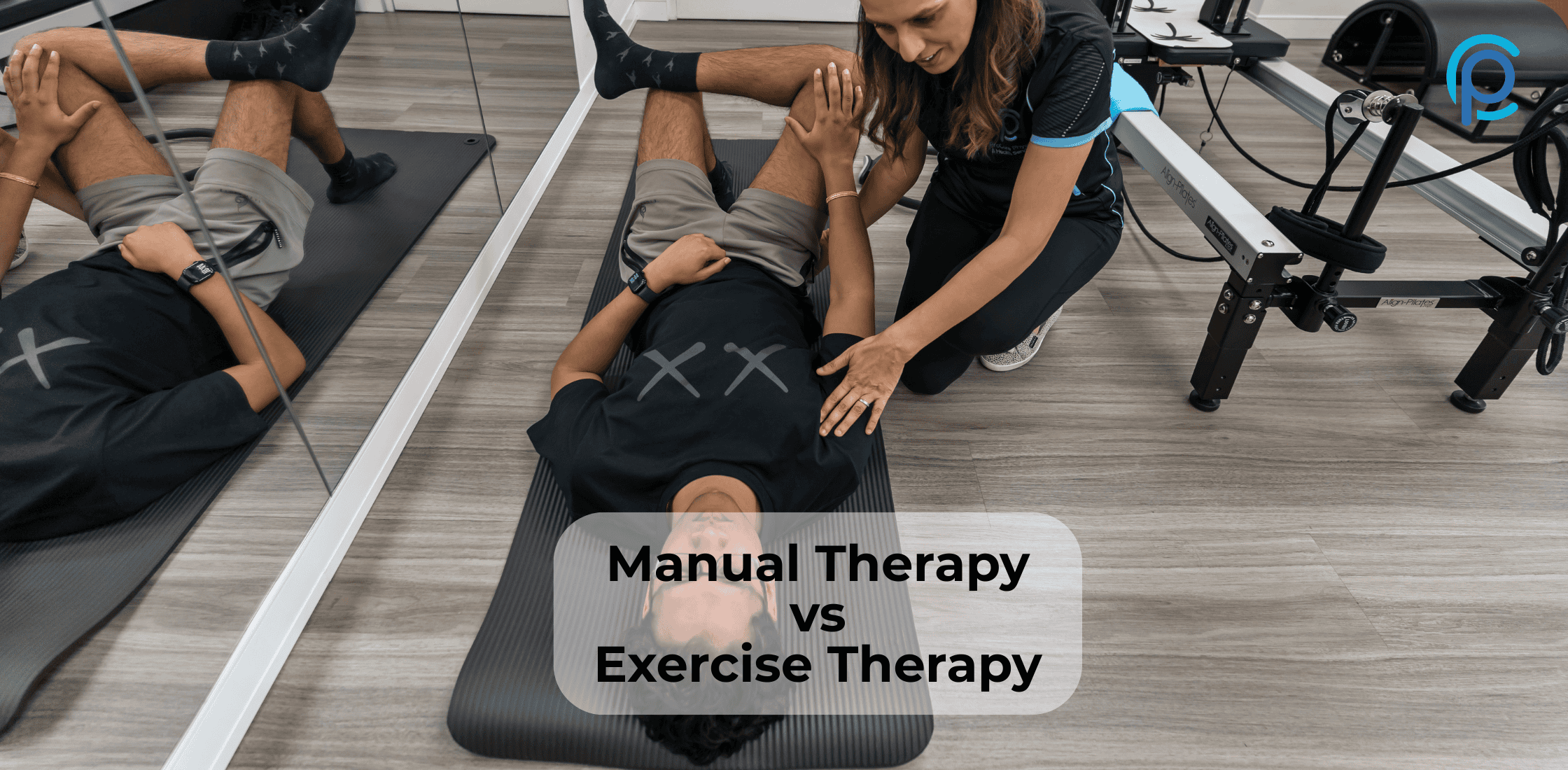When our patients walk into our clinic, struggling with each step, completely unsure of what to expect, just hoping that they will be fixed, I feel it’s a very big responsibility on our shoulders as their trusted physiotherapists.
If you are living with pain or struggling to overcome an old injury, you would have probably felt the same combination of feelings of hope and uncertainty. Trust me—we get it. Over the years, treating my patients at Procure Physio in Toongabbie, there’s one thing I can say for sure, no two recovery journeys look the same. Patients have heard terms such as manual therapy and exercise therapy either through their past experiences or something they’ve read online, but they lack a deeper understanding of what they mean and how they can benefit during different rehab stages.
Let me shed some light on these two cornerstone approaches we use daily and help you understand which might be right for your situation, or why many people discover a thoughtful blend of both often works wonders.
The “Hands-On” Approach: Understanding Manual Therapy
Manual therapy is exactly what it sounds like—it’s the hands-on mobilisation. It’s when your physio uses their trained hands to work directly on your body to ease pain, loosen tight spots, and help joints move better.
We have many ankle injury patients coming in with a condition where they can barely stand straight. After a thorough assessment, I start with gentle manual techniques to ease their muscle spasms before they can even think about doing exercises.
When we talk about manual therapy, we’re including
Joint work: Careful movements where we guide your joints through ranges they might be struggling with—sometimes with a satisfying (and completely normal!) pop or click
Muscle release: Various massage techniques that help those knots and tight bands of muscle finally let go—sometimes tender but in that “good pain” kind of way
Fascia techniques: Working on that connective tissue web that wraps around everything in your body but tends to get sticky and restricted after injuries
Trigger point work: Finding those exquisitely tender spots that refer pain elsewhere and applying just the right pressure—you know the ones that make you go “Ouch! But also… thank you?”
I’ve noticed many of our Western Sydney patients initially seek us out specifically for this hands-on relief, especially when they’re in the “just make it stop hurting” phase. And fair enough—manual therapy often provides that immediate “ahhh” moment that can make all the difference when you’re in pain.
DIY Recovery: The Power of Exercise Therapy
Exercise therapy is where you become the star of your own recovery show. Rather than having things done TO you, this approach is all about what you can actively DO to get better.
Exercise therapy typically includes
Strengthening work: Targeted exercises to build up muscles that might be weak or imbalanced—sometimes using your body weight, resistance bands, or weights
Stretching sequences: Specific stretches designed for YOUR tight spots—not just generic ones from YouTube
Balance and coordination training: Exercises that retrain your body’s awareness of itself in space—particularly important after injuries
Functional movement patterns: Practicing real-life movements that matter to YOU—whether that’s lifting grocery bags, playing with grandkids, or getting back to your weekend tennis matches
In our Toongabbie practice, exercise therapy is essential for lasting results. While manual therapy might give you that initial relief, the exercises are what keep the pain from coming right back the minute you leave our clinic.
So Which One Is Better? (Spoiler: It’s Complicated)
Here’s where I’d love to give you a simple answer… but I’d be doing you a disservice if I did. The truth is messier and more interesting than a simple either/or.
When Manual Therapy Shines
Manual therapy tends to be particularly helpful when:
You’re in such pain you can barely move (been there, felt that)
Your neck or back has “locked up,” and you’re walking like a robot
Your muscles are in full-on spasm mode
You need some relief BEFORE you can even think about exercising
You’ve got specific issues like a frozen shoulder or that sciatic nerve pain shooting down your leg
The immediate relief from good manual therapy in Toongabbie can be profound. I’ve seen patients walk in hunched over and walk out standing tall after a session. But—and this is important—that relief is often temporary unless we address the underlying issues.
When Exercise Therapy Takes the Lead
Exercise therapy usually becomes the star of the show when:
The worst of your pain has settled down
You’re ready to do some of the heavy lifting in your recovery (literally!)
You need to rebuild strength after being laid up for a while
You want to make sure this problem doesn’t just keep coming back
You’re itching to get back to your regular activities without fear
The beauty of exercise therapy is that it puts you in control. Once you know what to do, you can maintain your progress anywhere—at home, at work, even while watching your kid’s Saturday morning football match.
The Secret Sauce: Why We Almost Always Use Both
Honestly? After 20 years of treating everyone from desk workers with nagging neck pain to weekend warriors with twisted ankles, I rarely use just one approach.
At Procure Physio, we think the “versus” in “Manual Therapy vs. Exercise Therapy” is misleading. It’s not an either/or situation—it’s a both/and scenario, with the balance shifting as you progress.
This blended approach is what we’ve found works best for virtually all our Toongabbie patients. We might start hands-on to “clear the path,” but we’re always working toward getting you independently strong and functional.
Finding Your Personal Recovery Recipe
I’m often asked, “But what’s right for ME?” The answer depends on several factors:
The nature and stage of your injury
Your personal health goals
Your previous experiences with physio
Your lifestyle and time constraints
Even your personal preferences about treatment styles
Some people love the feeling of manual therapy and the immediate relief it brings. Others prefer being active participants and diving straight into exercises.
The beauty of coming to an experienced physiotherapist is that we can tailor the perfect blend for YOUR specific situation.
Ready to Find Your Path to Recovery?
At Procure Physio in Toongabbie, we see beyond your symptoms and work on a holistic treatment plan by getting to know you to understand what matters most to you and creating a path to getting you back to doing what you love.
Are you looking for hands-on treatment, exercises, or, as in most cases, a combination of the two techniques? Drop in or give us a call, and we’d love to help you find your personal path to feeling better.
Because at the end of the day, the “right” therapy isn’t about manual versus exercise—it’s about what helps you get back to living your best life, pain-free.
Unsure which approach suits your needs? Visit the best physiotherapy clinic in Toongabbie for expert assessment of manual vs. exercise therapy: which is right for you? Our specialists create personalized recovery plans for lasting results. Book now!

